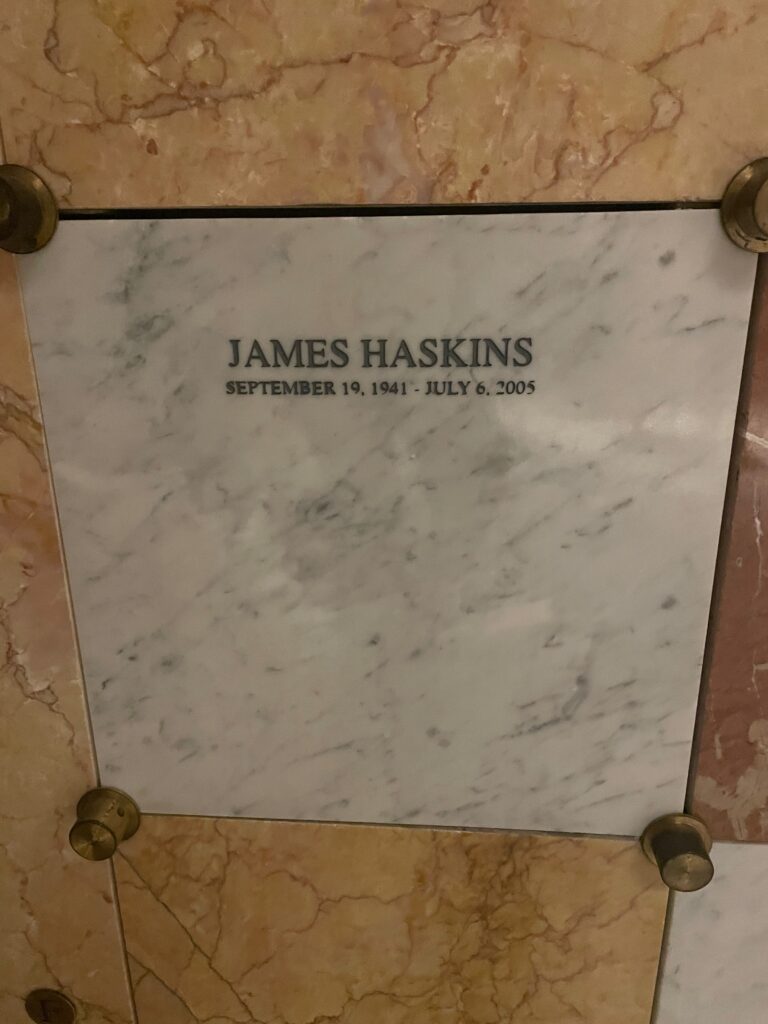Erik Visits an American Grave, Part 1,676
This is the grave of James Haskins.

Born in 1941 in Demopolis, Alabama, Haskins and his family moved to Boston in about 1953, where he graduated from high school. The kid was brilliant from the time he was small. He didn’t have a lot of advantages though. He went through the segregated schools of his time. Luckily, the boss of one of his parents realized the kid was bright and allowed him to use his library card. What I gather from this, although I cannot confirm it, is that the library was segregated and Black people couldn’t check out books.
When the family moved to Boston, Haskins got into a pretty elite school based on his brilliance. He thrived there and after graduation, went to Alabama State, got kicked out for civil rights activism (remember that most of the Black elite in the South actually opposed civil rights activism out of fear and also out of protecting their little fiefdoms they had carved out through agreements with white elites), then went to Georgetown, graduating in 1960, despite being only 19. He went back south for a second bachelor’s degree at Alabama State in 1962, placing him right back in the civil rights struggle, and then went on for another master’s degree at the University of New Mexico (Go Lobos!!!!!). After graduating with his degrees, he moved to New York, where he worked in the stock market.
But the stock market did not move Haskins, even if it was a way to make a living. He wanted to be an educator and he created some really interesting ways to do that. First, he got a job teaching in Harlem. But then he stared writing. First he wrote about teaching, in a book called Diary of A Harlem School Teacher. But then he went into picture books for kids, mostly on Black history, and this really caught on. There was a huge market for this beginning in the 1960s, as parents began to look for ways to teach their kids outside of the white supremacist system that influenced not only schools, but also early childhood development. The classic example of this is the psychological experiments with white and black dolls that was so powerfully used in the arguments in Brown v. Board of Education. Even before they got to school, kids internalized that white people were good and black people were bad. So one way to fight this was to produce early childhood educational materials for children that pushed ideas of Black pride.
Haskins was a real pioneer of this, writing dozens of picture books for small children and then also dozens of books with more words for older kids too. A lot of these were books about Black musicians. He really burst on the scene in 1975 with one on Stevie Wonder. He had imbibed Black Power pretty heavily by the late 60s and wrote a book in 1972 called Profiles in Black Power, so it made sense for him to think in these terms, including with great contemporary musicians. But he went on to profile the Black past too, including books on Scott Joplin, Ada Bricktop Smith, and other legendary musicians. His Stevie Wonder book won the Coretta Scott King Award from the American Library Association, given out to kids and young adult books that reflect the African American experience. He would also be nominated for the award in 1978 for his book on Barbara Jordan, twice in 1980 for books on Andrew Young and James Van Der Zee, in 1984 for his book on Lena Horne, in 1991 for Black Dance in America, and in 1998 for a book on Bayard Rustin. Black Music in America, from 1988, also won the Carter G. Woodson Award from the National Council for Social Studies.
Haskins became the go-to person for Black history children’s literature. As such, he and Rosa Parks decided together to turn her life into her memoir and so they co-wrote Rosa Parks: My Story, which was published in 1999. The book was noted for its straightforward language and ease in communication. One assumes Haskins is the reason for this, not because Parks couldn’t tell her own story, but these books need shaping. Parks wasn’t a professional author and storyteller. Haskins was those things. Anytime you see one of these memoirs co-written with someone, this is what you can assume has happened. Nothing wrong with that, not at all.
Haskins was a major league smoker and that is what did him in, in 2005, when he died of emphysema. He was 63 years old.
James Haskins is buried in Cathedral Church of St. John the Divine, Manhattan, New York.
If you would like this series to visit other winners of the Coretta Scott King Award, you can donate to cover the required expenses here. Charlemae Robbins, who won in 1971 for a book on Langston Hughes, is in Alsip, Illinois. Pearl Bailey, the legendary actress and dancer who won in 1976 for Duey’s Tale, is in West Goshen Township, Pennsylvania. Previous posts in this series are archived here and here.
